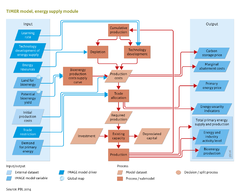Energy supply: Difference between revisions
Jump to navigation
Jump to search
No edit summary |
No edit summary |
||
| Line 4: | Line 4: | ||
|FrameworkElementType=pressure component | |FrameworkElementType=pressure component | ||
|Status=On hold | |Status=On hold | ||
|KeyReference=De Vries et al., 2007; Van Vuuren et al., 2008; Van Vuuren et al., 2009; | |KeyReference=De Vries et al., 2007; Van Vuuren et al., 2008; Van Vuuren et al., 2009; | ||
|InputVar=Technology development; Energy resources; Trade restrictions; Demand for primary energy; Land for bioenergy | |InputVar=Technology development; Energy resources; Trade restrictions; Demand for primary energy; Land for bioenergy | ||
|OutputVar=Primary energy price; Carbon storage cost; Bioenergy crops production; Energy security indicators; Total primary energy supply; Marginal abatement cost; | |OutputVar=Primary energy price; Carbon storage cost; Bioenergy crops production; Energy security indicators; Total primary energy supply; Marginal abatement cost; | ||
|Parameter=Initial production costs of energy supply technologies | |Parameter=Initial production costs of energy supply technologies | ||
|Description=The supply of different energy resources obviously forms a key component of the energy system. On the one hand, supply is constrained on an annual (for renewables) or cumulative (for fossil and nuclear) basis. In addition, resources are unevenly spread across world regions and often poorly matched with regional energy requirements. It relates directly to the notion of energy security, but also determines to a large extent the many environmental impacts of the energy system. The IMAGE energy model [[TIMER|TIMER | |Description=The supply of different energy resources obviously forms a key component of the energy system. On the one hand, supply is constrained on an annual (for renewables) or cumulative (for fossil and nuclear) basis. In addition, resources are unevenly spread across world regions and often poorly matched with regional energy requirements. It relates directly to the notion of energy security, but also determines to a large extent the many environmental impacts of the energy system. The IMAGE energy model [[TIMER model|TIMER]] concentrates on long-term dynamics, not on short term market conditions. For all primary energy carriers, costs are based in the long run on the interplay between resource depletion (upward pressure on prices) and technology development (downward pressure on prices). In the model, technology development is introduced for most fuels and renewable options as learning curves: costs decrease endogenously as a function of cumulative capacity in place in some cases exogenous technology change assumptions are made. Depletion is a function of either cumulative production, as for fossil fuel resources and nuclear feedstocks, or of annual production as for renewables. | ||
The supply of energy is assumed to be a function of total demand in the sense that all demand is always met. Because regions can usually not supply all demand, energy carriers such as coal, oil and gas are widely traded. The supply model influences developments in the demand and conversion models via prices: primary fuel prices influence investment decisions in end-use and energy conversion. Linkages to other parts of IMAGE are the available land for bio-energy production and the emissions of greenhouse gas and air pollutants (partly related to supply) and the use of land for bio-energy production (no account is made for land use for other energy forms). Several key assumptions determine the long-term behavior of the various energy supply submodels. There are mostly related to technology development and the resource base. The various links are indicated in the table below. | |||
}} | }} | ||
Revision as of 15:40, 9 December 2013
| Component is implemented in: |
|
| Related IMAGE components |
| Projects/Applications |
| Key publications |
Key policy issues
- How can energy resources be exploited to meet future primary energy demand?
- How can energy supply and demand be balanced between world regions, and how will this effect security of supply?
- How rapidly can the transition to more sustainable energy supply be made?
